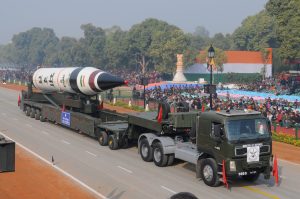Harsh Vasani

On March 11, 2024, India’s Defense Research and Development Organization (DRDO) tested the country’s maiden MIRV (multiple independently targetable re-entry vehicle) missile using its Agni-V intercontinental ballistic missile (ICBM). The test was code-named “Mission Divyastra” and was carried out from Dr. Abdul Kalam Island, in Odisha, while telemetry and radar stations tracked and monitored multiple re-entry vehicles.
The test displayed the ability of India’s strategic forces to load multiple warheads on a single missile, which can then deliver the warheads inside enemy territory, evading the latter’s missile defense systems. The missile can also carry decoys that can elude countermeasures from the enemy. Moreover, there is an economic rationale to the test since MIRV technology allows multiple warheads to be loaded onto a single, often very expensive, missile – thereby increasing lethality at a cheaper cost.
Analysts point out that MIRV capability strengthens India’s nuclear counterstrike capabilities, gives it the ability to evade any current and future ballistic missile defense (BMD) systems, and allows India’s strategic forces to substitute accuracy for firepower.
The test demonstrates that India’s national security establishment has successfully miniaturized nuclear warheads that can be tipped on ICBMs – this is important to highlight since limited testing, including the 1998 tests, raised questions about India’s ability to design miniaturized warheads. Other elements of the MIRV test are not discussed as much but nevertheless provide insight into India’s evolving strategic thinking.
First, while the MIRV test was designed to showcase India’s second-strike capability, the ability to launch multiple smaller loads on a single missile shows that in case of an attack on India’s CISR (communication, intelligence, surveillance, and reconnaissance) satellites by a hostile power, the DRDO can quickly launch into orbit miniaturized satellites that can act as India’s eyes in the sky. These satellites can be launched to replace damaged satellites and restore crucial communication and surveillance networks. The ability to offset an enemy’s anti-satellite attacks should be seen in light of India’s own space weapons program that was tested in March 2019.
V. K. Saraswat, a former scientific adviser to the defense minister and former director-general of DRDO, said a modified Agni-V could launch mini-satellites. He claimed that the Agni-V could launch satellites into low-earth orbit to restore communication links “in the event of the country being denied access to its satellite constellations by the enemy.”
India’s ability to design miniaturized satellites was demonstrated in 2017, when the Indian Space Research Organization (ISRO) set a world record by placing into Sun-synchronous orbit 104 satellites in a single mission.
The recent MIRV test also confirms a poorly kept secret – the military utility of India’s civilian ISRO. The designs of the Agni series of missiles developed by the DRDO are reportedly based on the ISRO’s satellite launch vehicles (SLVs) with the first iteration of the Agni being based on the ISRO’s SLV-3 with modifications to ensure higher payloads can be fitted on the missiles.
The DRDO is working on its satellite launch vehicles, based on the ISRO’s SSLV (small satellite launch vehicle), that will allow all branches of the military to launch satellites. The design of the SSLV will allow satellite launches within a quick turnaround time with minimal infrastructure requirements, meaning it can be launched from a multi-axle TEL (transporter erector-launcher) vehicle.
Finally, the militarization of the ISRO is evident with the frequent move of officials from the ISRO to the DRDO. For instance, Mission Divyastra was officially led by missile expert R. Sheena Rani who works at the DRDO’s Advanced Systems Laboratory (ASL) in Hyderabad. She was previously with the ISRO for eight years at the Vikram Sarabhai Space Center.
No comments:
Post a Comment